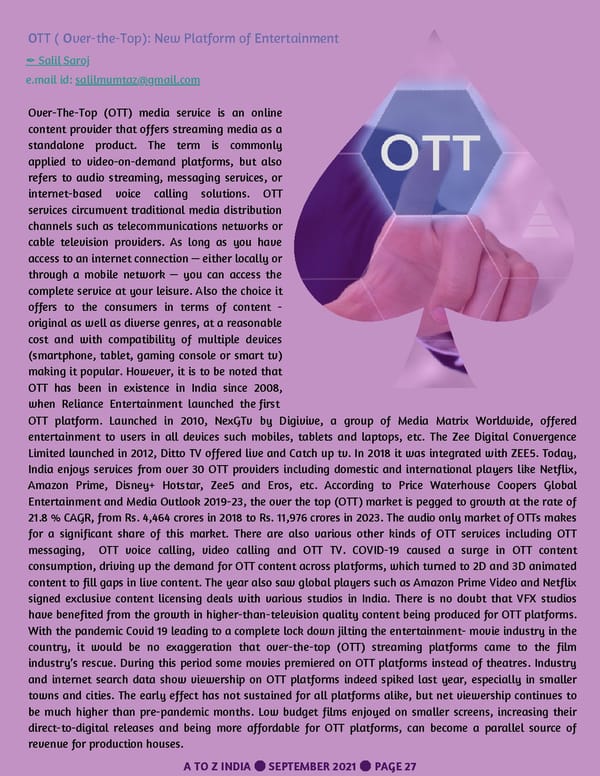OTT ( Over-the-Top): New Platform of Entertainment ✒ Salil Saroj [email protected] e.mail id: Over-The-Top (OTT) media service is an online content provider that offers streaming media as a standalone product. The term is commonly applied to video-on-demand platforms, but also refers to audio streaming, messaging services, or internet-based voice calling solutions. OTT services circumvent traditional media distribution channels such as telecommunications networks or cable television providers. As long as you have access to an internet connection — either locally or through a mobile network — you can access the complete service at your leisure. Also the choice it offers to the consumers in terms of content - original as well as diverse genres, at a reasonable cost and with compatibility of multiple devices (smartphone, tablet, gaming console or smart tv) making it popular. However, it is to be noted that OTT has been in existence in India since 2008, when Reliance Entertainment launched the first OTT platform. Launched in 2010, NexGTv by Digivive, a group of Media Matrix Worldwide, offered entertainment to users in all devices such mobiles, tablets and laptops, etc. The Zee Digital Convergence Limited launched in 2012, Ditto TV offered live and Catch up tv. In 2018 it was integrated with ZEE5. Today, India enjoys services from over 30 OTT providers including domestic and international players like Netflix, Amazon Prime, Disney+ Hotstar, Zee5 and Eros, etc. According to Price Waterhouse Coopers Global Entertainment and Media Outlook 2019-23, the over the top (OTT) market is pegged to growth at the rate of 21.8 % CAGR, from Rs. 4,464 crores in 2018 to Rs. 11,976 crores in 2023. The audio only market of OTTs makes for a significant share of this market. There are also various other kinds of OTT services including OTT messaging, OTT voice calling, video calling and OTT TV. COVID-19 caused a surge in OTT content consumption, driving up the demand for OTT content across platforms, which turned to 2D and 3D animated content to fill gaps in live content. The year also saw global players such as Amazon Prime Video and Netflix signed exclusive content licensing deals with various studios in India. There is no doubt that VFX studios have benefited from the growth in higher-than-television quality content being produced for OTT platforms. With the pandemic Covid 19 leading to a complete lock down jilting the entertainment- movie industry in the country, it would be no exaggeration that over-the-top (OTT) streaming platforms came to the film industry’s rescue. During this period some movies premiered on OTT platforms instead of theatres. Industry and internet search data show viewership on OTT platforms indeed spiked last year, especially in smaller towns and cities. The early effect has not sustained for all platforms alike, but net viewership continues to be much higher than pre-pandemic months. Low budget films enjoyed on smaller screens, increasing their direct-to-digital releases and being more affordable for OTT platforms, can become a parallel source of revenue for production houses. A TO Z INDIA ● SEPTEMBER 2021 ● PAGE 27
 A TO Z INDIA - SEPTEMBER 2021 Page 26 Page 28
A TO Z INDIA - SEPTEMBER 2021 Page 26 Page 28